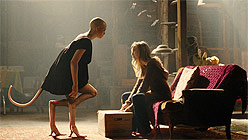Creating new life is a messy business — so said Mary Shelley, writing in the early 19th century in Frankenstein, or the Modern Prometheus. So you’d think, given all the gene-mapping and cloning going on nowadays, that horror movies would be lousy with Frankenstein scenarios — cautionary tales in which technology outpaces our understanding of how to use it. But mostly we have splatter flicks, torture porn and lame remakes. In that context, Vincenzo Natali’s Splice calls to us like a luminous laboratory beaker. What a strange and wonderful brew!
It’s set in Toronto and owes a lot to David Cronenberg, especially his films The Brood and The Fly. Throw in Splice and you can start to define an Ontario subgenre: faceless, sterile modern settings, wintry and blue-lit, in which monsters are grown or hatched. And those monsters have a metaphorical component; they’re as much a product of wayward emotions as of liberated biochemistry.
In Splice, Canada’s own Sarah Polley and long-faced Adrien Brody play Clive and Elsa, celebrated nerdy scientists splicing genes for a pharmaceutical company — called, in fact, NERD, for Nucleic Exchange Research and Development. When we meet them, they’re delivering a new life form, literally, from some kind of pulsing ovum in an incubator — a giant, wormy, wriggling mass of tissue from which they’re going to mine all kinds of patent-worthy medical processes.
But then company bigwigs put the kibosh on future research: Use what’s there and generate capital, they command. That’s when Clive and Elsa think: Why not mix in some human DNA and see what grows? Just to, you know, prove they can. After a lot of tinkering, the implant takes. The fetus — a kitchen sink’s worth of species — comes quickly to term. And then we hear the words immortalized first in 1931 by Frankenstein‘s Colin Clive: “It’s alive.”
Clive is about to gas the lab and kill the infant creature, but to stop him, Elsa whips off her oxygen helmet. That’s the first sign in Splice that the two will approach this “child” from different angles. Clive, very nervous, wants to kill it. Elsa develops less scientific feelings.


